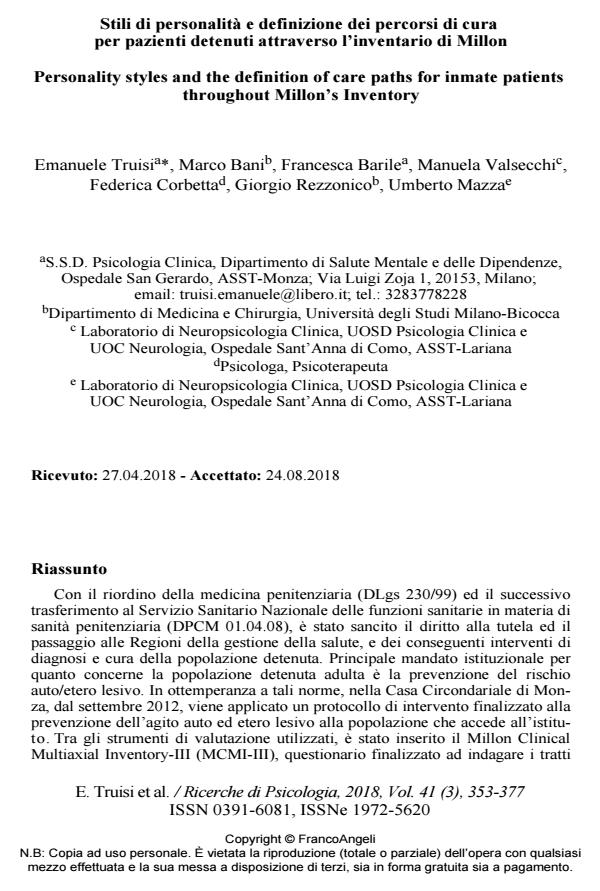Personality styles and the definition of care paths for inmate patients throughout Millon’s Inventory
Journal title RICERCHE DI PSICOLOGIA
Author/s Emanuele Truisia, Marco Bani, Francesca Barile, Manuela Valsecchi, Federica Corbetta, Giorgio Rezzonico, Umberto Mazza
Publishing Year 2018 Issue 2018/3
Language Italian Pages 25 P. 353-377 File size 168 KB
DOI 10.3280/RIP2018-003004
DOI is like a bar code for intellectual property: to have more infomation
click here
Below, you can see the article first page
If you want to buy this article in PDF format, you can do it, following the instructions to buy download credits

FrancoAngeli is member of Publishers International Linking Association, Inc (PILA), a not-for-profit association which run the CrossRef service enabling links to and from online scholarly content.
With the reorganization of Penitentiary Medicine (DLgs 230/99) and the transfer to National Health Service as regards the healthcare of inmates (DPCM 01.04.08), Italian regions have to manage diagnostic processes and therapies of prisoners. Main aim of the Organization for adult inmates is to prevent self and other injurious behaviours. In these frame, within inmates entering in prison, an intervention protocol has been carried out at the Penitentiary of Monza, since September 2012. Millon Clinical Multiaxial Inventory-III (MCMI-III) is assessed in order to investigate the personality structure and functioning. Personality assessment in penitentiary context is important to know the patient’s personality style and coping behavior, useful to cope with the new condition of living. As indicated by the literature, the scores obtained to Millon Clinical Multiaxial Inventory- III subscales can guiding treatment decisions: after analyzing the personality profile report, the clinician makes a diagnosis and, having verified the validity indexes, he determines the three highest scores among the personality patterns, the severe personality disorders, and the Axis I clinical syndromes (both severe and moderate). Hence feedbacks about vulnerabilities to be treated given to the patient determine the care path to be followed, defining the intervention goals with the patient.
Keywords: Inmates, self-injurious behaviours, Millon, personality styles, sex offenders.
Emanuele Truisia, Marco Bani, Francesca Barile, Manuela Valsecchi, Federica Corbetta, Giorgio Rezzonico, Umberto Mazza, Stili di personalità e definizione dei percorsi di cura per pazienti detenuti attraverso l’inventario di Millon in "RICERCHE DI PSICOLOGIA " 3/2018, pp 353-377, DOI: 10.3280/RIP2018-003004